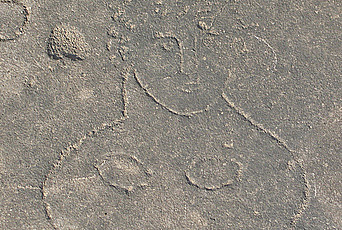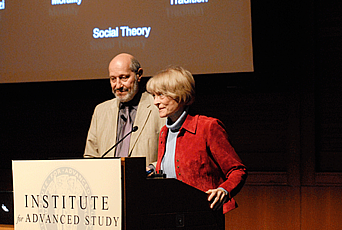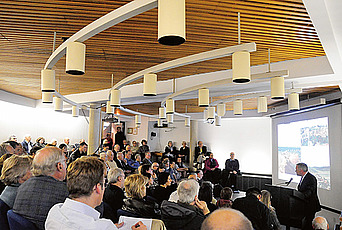Civic Identity at Ostia, Rome's Harbor Town

Besides Rome itself, there are principally two cities in Roman Italy that vie for the attention of both scholars and the public at large: Ostia and Pompeii. The latter is known for its tragic end in the volcanic eruption of 79 C.E., for fascinating wall paintings, and for millions of tourists who every year trample its sunbaked streets. Ostia suffers from relative neglect. Situated too close to the attractions of eternal Rome, the town draws many fewer visitors than its monuments and its overall importance would deserve, even though its green pine trees and the lush vegetation help make it into a peaceful historical oasis at the very mouth of the Tiber River.
From a historical perspective, Ostia was a more important settlement than Pompeii. With a population of perhaps as many as fifty thousand inhabitants, the town was much larger than its “rival.” More significantly, while Pompeii’s history was cut short when Rome’s imperial period was only in its infancy, Ostia, which was first settled in the fourth century B.C.E., still thrived during the third century C.E., and we have historical sources that allow us to follow its development well into the 400s.
At Ostia, the written sources, the lifeblood of historians, mostly consist of inscriptions that Roman stonecutters and manufacturers inscribed on funerary monuments, public buildings, everyday objects, and even lead water pipes. This creates a particular challenge for scholars like myself who want to understand the mentality of the Ostians, how they felt about their place in the world and about their hometown. Was there a particular ideology that informed their actions and decisions, or, more likely, a welter of convictions and beliefs about what it meant to be an Ostian? There are no letters, no diaries, and of course, no interviews that could shed light on these questions. The city archive, the minutes of the council meetings and of the local citizen assembly are long lost.
Some scholars think that in Roman times, as today, Ostia lived in the shadow of the capital (distant less than twenty miles), and that the harbor town was no more than a suburb of Rome, lacking an identity of its own. For various reasons, this argument fails to convince. I have been studying various aspects of Ostia for two decades or more: the infrastructure (the supply and distribution of water), the local government, the influence and control of the emperors, the city’s slaves and freed slaves, the immigration to the city, its character as one of the major ports in all of the Mediterranean Sea and a key to supplying the capital Rome, to name a few issues. At the Institute, I had a much-appreciated opportunity to tackle these issues and many more within the framework of investigating the civic identity of the Ostians. The issue of “identity” is rightly a popular topic these days in many sectors of historical (and other kinds of) research, but nobody has attempted to study Rome’s harbor town from this perspective. It may be that teasing out the relevant information from the almost six thousand surviving inscriptions from Roman Ostia has seemed too daunting a task.
In my work at the Institute, I focused on inscriptions that alert us to the presence of historical memory at Ostia. Here is a modern example of what I mean: a bronze plaque affixed to the southern façade of City Hall in Philadelphia reminds the townspeople that the first Europeans on the site were settlers from Sweden and Finland, who in the early 1600s attempted to build up New Sweden. (Some early leaders of this immigrant community are named; one was called John Rambo.) In fact, bronze plaques with historical information can be found all over North America. Nothing this programmatic and organized existed at Ostia, but we find public statues and memorials of great Ostians with extensive information on their deeds and benefactions to their community. For example, there is the local magnate Lucilius Gamala the Elder (active in the 50s–30s B.C.E.), who was honored in public because of the many gifts he bestowed upon his fellow citizens, among which was a public feast for which 217 sets of dining couches were prepared, thus accommodating almost 2,000 guests. What is this if not a demonstration of “Ostianness” (combined, as always, with a wish for personal glory and renown)? To this comes the fact that the inscription that recounts Gamala’s benefactions was recut in the middle of the second century C.E. The occasion was a series of similar good deeds in favor of the Ostians by a much later descendant, Lucilius Gamala the Younger. This set of texts illustrates both the existence of Ostian patriotism and the importance of local historic memory.
Ostia’s claim to being the first settlement (colonia) of Roman citizens outside Rome is celebrated in a text that praises the legendary founder, Rome’s fourth king, Ancus Martius. Then there is the public chronicle (the Fasti Ostienses), annually inscribed on great marble slabs, as far as we know a unique feature among Roman towns, which records Roman consuls and Ostia’s local magistrates, combined with important events often related to the imperial family and thus demonstrating imperial loyalty, year by year for centuries. Here one reads about how the Ostians solemnly received the body of the emperor Augustus’s adopted son Lucius Caesar in 2 C.E. and accompanied it onwards on the journey from Massilia in southern France to Rome. More happily, in 140 C.E. a statue of the future emperor Marcus Aurelius was erected, while in 152, a private citizen dedicated a public building, a basilica, for which he had paid. On this occasion, he also offered the townspeople a gladiatorial spectacle and a wild beast hunt, and dedicated two statues representing the Genius and the Fortuna of the people of Ostia. It becomes clear that Ostia was much more than a suburban satellite of Rome, as modern scholars often suggest. As far as we can judge, its inhabitants were proud of their close relationship with the capital but certainly stressed their own achievements.
A very particular view of Roman history is manifested in the recently restored inscriptions that decorated the main city gate, used by travelers between Ostia and Rome. It dates to shortly before 100 C.E. and recalls the contribution of both the consul Cicero and of the tribune of the people Publius Clodius towards building the city wall and the gate in the 50s B.C.E., or a century and a half earlier. Those familiar with Roman history know that the two men were mortal enemies, one defending the establishment and the other opposing it either out of demagoguery or perhaps conviction. Clodius’s memory is permanently denigrated thanks to Cicero’s many surviving writings, and no other source from antiquity shows a similarly inclusive view of Roman history as this Ostian text. It is as if the Ostians were thinking: “Well, these men of the past were both great Romans. They had their quarrels back then, but that’s over. Instead of dwelling on that, let us remember fondly that two men who play conspicuous roles in the glorious annals of our nation’s history also looked out for Ostia. Our Ostia was important already then, as everyone can see.”
For the Ostians to celebrate Cicero and Clodius in the same public inscription is, perhaps, a bit like if in the United States today we were to find a town or perhaps a hotel owner somewhere proudly announcing (knowing that it would attract general benevolence) that both President Lincoln and President Jefferson Davis had been patrons of the locality in the early 1860s. For all I know, such public inscriptions may exist, but I have a feeling they are rare.
As for the inscription on the gate of Ostia, it is unique in its inclusive view of history. On the other hand, it can also be said to be typically Roman. A general strength of Roman civilization was its ability to overcome deep social schisms that from time to time threatened to rend asunder the state.


